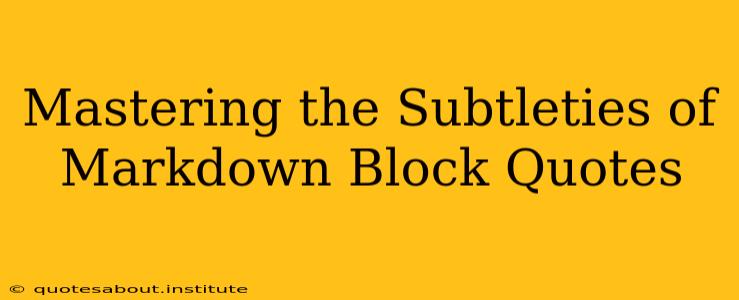Markdown's block quote functionality is deceptively simple. At first glance, it's just a way to visually set apart a section of text. However, understanding the nuances of block quotes—their formatting, applications, and best practices—can significantly elevate the clarity and impact of your writing, whether you're crafting a technical document, a compelling blog post, or a simple email. This guide dives deep into the subtleties of Markdown block quotes, ensuring you harness their full potential.
What is a Markdown Block Quote?
A Markdown block quote is used to visually distinguish a section of text from the surrounding content. It's typically used to:
- Highlight important excerpts: Like pulling a key passage from a research paper.
- Showcase a quote from someone else: Attributing the words directly to their source.
- Create a visually appealing separation: Breaking up long sections of text to improve readability.
- Indicate a change in speaker or perspective: In a dialogue or narrative.
Technically, a block quote is created by prefixing each line of the quoted text with a > character. For example:
> This is a block quote. It's easy to create!
>
> You can even have multiple lines.
>
> And leave blank lines in between.
This renders as:
This is a block quote. It's easy to create!
You can even have multiple lines.
And leave blank lines in between.
Nested Block Quotes: Adding Layers of Meaning
Markdown also allows for nested block quotes, creating a hierarchy of quoted material. This is achieved by adding additional > characters at the beginning of each line.
> This is the main quote.
>> This is a nested quote, within the main quote.
>>> And this is a further nested quote.
This will render as:
This is the main quote.
This is a nested quote, within the main quote.
And this is a further nested quote.
Nested block quotes are invaluable for representing conversations, indicating layered sources, or providing commentary within a quote.
Combining Block Quotes with Other Markdown Elements
The true power of Markdown block quotes comes from their compatibility with other Markdown elements. You can seamlessly incorporate:
- Bold and italic text:
> This is a **bold** and _italic_ block quote. - Lists:
> * Item 1 > * Item 2 > * Item 3 - Links:
> Check out this great resource: [Example Link](https://www.example.com) - Code blocks:
> ```python > print("Hello, world!") > ```
This flexibility allows for rich, expressive block quotes that convey complex information efficiently.
Using Block Quotes for Attribution
Proper attribution is crucial when using block quotes, especially when quoting external sources. Always clearly indicate the source of the quote, typically after the block quote using a Markdown reference or a simple parenthetical citation. For example:
> "The greatest glory in living lies not in never falling, but in rising every time we fall."
> - Nelson Mandela
Or:
> "The quick brown rabbit jumps over the lazy frogs." (Source: My Amazing Novel, Chapter 3)
Failing to properly attribute quotes can lead to plagiarism and damage your credibility.
Best Practices for Markdown Block Quotes
- Keep them concise: Avoid excessively long block quotes. Extract the most relevant portions.
- Use them sparingly: Overuse can disrupt the flow of your writing.
- Maintain consistency: Apply a consistent style throughout your document.
- Ensure readability: Use appropriate formatting and line breaks to improve readability.
By mastering the subtleties of Markdown block quotes, you can create more engaging, informative, and well-structured content. The ability to seamlessly integrate them with other Markdown elements opens up a world of possibilities for effective communication. Remember to always prioritize clarity and proper attribution to maintain credibility and professionalism.

